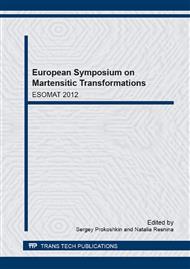[1]
Sato A., Chishima E., Soma K., Mori T. Shape memory effect in g↔e transformation in Fe-30Mn-1Si alloy single crystals. Acta Metall. 30 (1982) 1177-1183.
DOI: 10.1016/0001-6160(82)90011-6
Google Scholar
[2]
H. Otsuka, M. Murakami, S. Matsuda, in: M. Doyama, S. Somiya, R. Chang (Eds. ), Proceedings of the MRS International Meeting on Advanced Materials, vol. 9, Materials Research Society (1988) 451–456.
Google Scholar
[3]
Kajiwara S. Characteristic features of shape memory effect and related transformation behavior in Fe-based alloys. Mater. Sci. Eng. A 67 (1999) 273–275.
DOI: 10.1016/s0921-5093(99)00290-7
Google Scholar
[4]
Stanford N., Dunne D.P. Effect of NbC and TiC precipitation on shape memory in an iron-based alloy. J. Mater. Sci. 41 (2006) 4883-4891.
DOI: 10.1007/s10853-006-0050-7
Google Scholar
[5]
Druker A., Sobrero C., Brokmeier H. -G., Malarría J., Bolmaro R. Texture evolution during thermomech. treatments in Fe-Mn-Si shape memory alloys. Mater. Sci. Eng. A 481–482 (2008) 578–581.
DOI: 10.1016/j.msea.2006.10.214
Google Scholar
[6]
Herrera C., de Lima N.B., Kliauga A.M., Padilha A.F. Microstructure and texture of duplex stainless steel after melt-spinning processing. Mater. Charact. 59 (2008) 79–83.
DOI: 10.1016/j.matchar.2006.10.022
Google Scholar
[7]
Donner P., Hornbogen E., Sade M. Shape memory effects in melt-spun Fe-Mn-Si alloys. J. Mater. Sci. Lett. 8 (1989) 37-40.
DOI: 10.1007/bf00720244
Google Scholar
[8]
Valeanu M., Filoti G., Kuncser V., Tolea F., Popescu B., Galatanu A., Schinteie G., Jianu A.D., Mitelea I., Schinle D., Craciunescu C.M. Shape memory and associated properties in Fe–Mn–Si-based ribbons produced by melt-spinning. J. Mag. Magnetic Mater. 320 (2008).
DOI: 10.1016/j.jmmm.2008.02.105
Google Scholar
[9]
Druker A., Perotti A., Baruj A., Malarría J. Heat Treatments of Fe-Mn-Si Based Alloys: Mechanical Properties and Related Shape Memory Phenomena. J. ASTM Int. 8, No. 4 (2011) Paper ID JAI103399. Available online at www. astm. org.
DOI: 10.1520/jai103399
Google Scholar
[10]
Maji B., Madangopal K, Rama Rao V. V. The microstructure of an Fe-Mn-Si-Cr-Ni stainless steel shape memory alloy. Met. Mater. Trans. A 34a (2003) 1029-1042.
DOI: 10.1007/s11661-003-0124-y
Google Scholar
[11]
Jiang B.H., Sun L., Li R., Hsu T.Y. Influence of austenite grain size on g→e martensitic transformation temperature in Fe-Mn-Si-Cr. Scr. Met. et Mater. 33 (1995) 63-68.
DOI: 10.1016/0956-716x(95)00081-6
Google Scholar


